Pallet Jack Ergonomic Best Practices – [Quick & Easy]
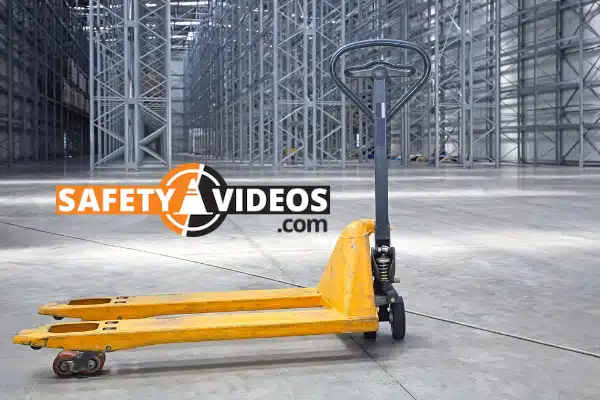
Palletized loads are one of the biggest areas of concern when it comes to ergonomic warehouse and manufacturing safety concerns. So, learning a good set of pallet jack ergonomic best practices can go a long way in preventing injuries.
Due to the safety hazards pallet jacks present, if they are not handled carefully, they are a priority when it comes to safety training in the warehouse. Teaching your team all about pallet jack ergonomics will go a long way in preventing injuries.
Below are the most ergonomic practices when using a pallet jack to ensure you and your employees are safe at all times. If you want a more thorough and complete pallet jack training, you should check out our full course. We also have a toolbox talk for Pallet Jacks as well.
Why Are Pallet Jack Ergonomics Important?
A palletized load presents several ergonomic challenges. However, following the best pallet jack practices outlined in this guide will help workers adapt by working with these tools rather than against them to complete daily tasks better.
Some ergonomic challenges specific to pallet jacks include:
- Heavy pallet components and loads are difficult to move with ease.
- Stacked pallets cause cartons to be located in different ergonomic zones. This can be dangerous because each pallet sits atop one another, may have different weights, and require more force to move.
- Pallets are often set up in a way that requires workers to access them from different sides and angles. Stacking or removing these pallets can be difficult and time-consuming.
- Pallets undergo various processes in different areas of the workspace. This means different workers access the materials at other times, which can cause additional hazards if not every worker is careful while moving or handling.

Many tasks in warehouse facilities come with ergonomic risk factors, such as:
- Forceful exertions
- Repetitive movements
- Twisting
- Bending
- Awkward posturing
These factors, in combination, can lead to musculoskeletal disorders.
The best practices for pallet jack handling reduce the number of physical adjustments workers must make to complete a task.
Automated and mechanical devices can also help reduce musculoskeletal stress while completing different tasks with pallet jacks.
Pallets are used in almost every industrial facility, so following the safest methods for handling them is crucial. Also, let’s not forget that OSHA has requirements for training that must be met.
Pallet Handling Ergonomics
Removing and adding loads is an ergonomic challenge.
Heavy loads have an increased risk of injury due to the force required to move them. But there are ways to relieve physical stress that would otherwise burden the body when loading and unloading pallet jacks.
A professional ergonomist can help determine the risk factors of different tasks and provide ways for workers to be safe and consistent with their handling. They can also identify issues and track the progress to develop new ways to solve problems in the warehouse.
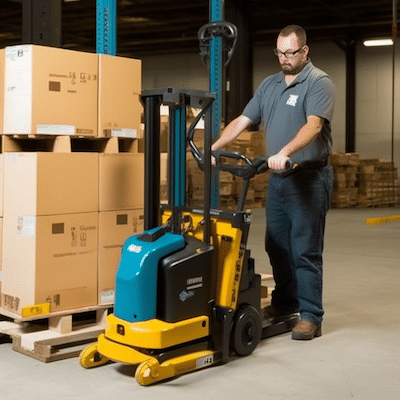
Manual Material Handling
Regarding manual handling, workers must utilize ergonomically friendly positions and allow them to work faster and more efficiently.
In most cases, loads should be accessed at a 30″ height, the average distance between the ground and a person’s knuckles. Following this rule will prevent workers from reaching higher or stooping lower to access their load, causing physical stress.
There are also a variety of lift systems that help workers access and transport their loads without bending or carrying heavy weights. This prevents the force from being too great to be lifted off the ground and moved.
How to Safely Handle Broken Pallets
Broken pallets must be thrown away or recycled to prevent accidents. Broken pallets should never block access points, walkways, or emergency equipment.
Pallet Transportation Ergonomics
The most strenuous part of using pallet jacks – what you might call the back-breaking problem – comes from moving heavy loads.
Workers must know when pushing or pulling is appropriate for the job. Pushing the load is the traditional purpose, but there are some cases when pulling may be necessary.
Additionally, different model types give workers more options when handling a load. These variations can help workers avoid back-breaking problems.
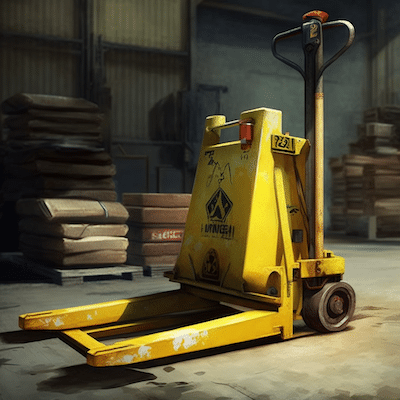
What Purpose a Pallet Truck Serves
Workers are often tempted to pull their pallet trucks. This makes sense because people naturally want to use their body weight to their advantage. When pushing, the weight comes closer and feels harder to manage.
The most strenuous part of operating a fully loaded pallet truck is getting the wheels rolling while pushing the truck. Once moving, a pallet truck serves the purpose of making pallets more portable. Workers should follow weight ratings to easily move them around.
How to Safely Maneuver a Fully Loaded Pallet Truck
Pallet jacks have a weight rating between 2,000 and 5,000 pounds. Workers should always stay within the rating of the pallet jack or pallet truck they use.
Never pull a heavy pallet truck. Instead, workers should always push the pallet truck to get the wheels rolling and move it to the desired area.
Pulling a fully loaded pallet truck is the most common way to stress the spinal column, leading to back pain and spine problems. Pulling the pallet truck also makes it harder to see in the travel direction, making it easier to trip or fall. There are only a few rare instances in which it may be necessary for a pallet truck operator to pull a fully loaded pallet jack.
Pushing presents its potential for injury, however. If workers push instead of pulling on the pallet truck, they need to take care not to put too much strain on their backs and shoulders from awkwardly moving against the weight of the truck.
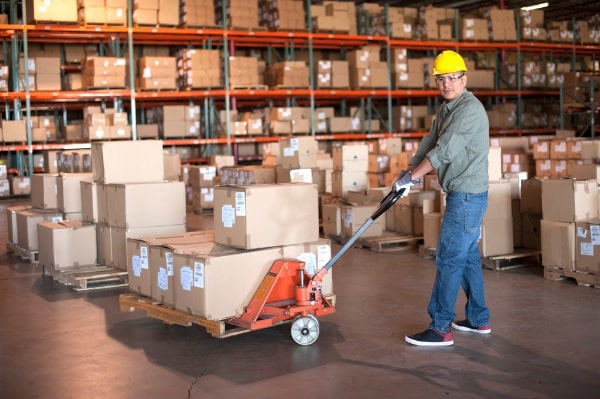
In other words, the hand grip controls all movement. Workers select their travel direction using the hand grip and can then lift loads off the ground and move them.
To do this, the handle must be in a downward position. Once in the downward position, the hand grip must be raised to move the truck forward.
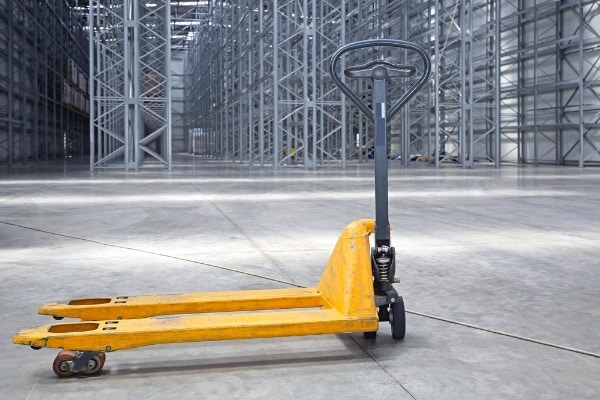
The Bottom Line
Maneuvering a pallet jack can be difficult. But if it’s part of your job, you must learn to control the device to keep yourself and others safe. That includes knowing the risks of using a pallet jack to transport heavy loads throughout your workplace. Knowing good pallet jack ergonomics will help keep employees safe and reduce on-the-job accidents and injuries.
Whether you work in manufacturing or another industry, knowing the correct way to lift and transport materials will keep you from injuring yourself and your coworkers.
FAQs on Pallet Jack Ergonomics:
Moving materials is hard work. Using good ergonomics when using a pallet jack helps in reducing accidents or injuries with your employees.
Adjustable handles, easy-to-use controls for lifting and lowering, and large wheels are all good things to look for.
– Keep your back straight
– Be sure to push the pallet jack instead of pulling it
– Make sure that you bend at the knees when loading or unloading
The lifting power of a pallet jack is lower than that of a forklift. Pallet jacks are also much smaller than forklifts, which means the loads their forks can carry are lighter, and they cannot travel long distances.
Pallet jacks are covered by the 1910.178 OSHA Standard.
Your arms and legs get the most work.